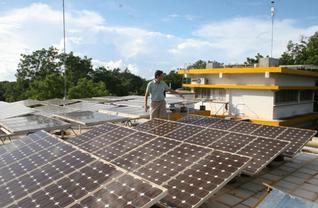Light from the roof
 What is the buzz word today in the world of renewable energy? Without much thinking, everyone will say solar energy, a rapidly expanding technology with unlimited potential. While many buildings are already getting their power supply largely from solar power systems, many more from offices with backup diesel generators to rural homes facing frequent power cuts are considering photovoltaic panels to supplement their grid power supply. We can see a future unfurling.
What is the buzz word today in the world of renewable energy? Without much thinking, everyone will say solar energy, a rapidly expanding technology with unlimited potential. While many buildings are already getting their power supply largely from solar power systems, many more from offices with backup diesel generators to rural homes facing frequent power cuts are considering photovoltaic panels to supplement their grid power supply. We can see a future unfurling.
It all starts with the basic home lighting systems to generate 250 v to 3,500 v with CFL or LED bulbs ranging in number between one and 10. There would be a PV or photovoltaic panel, also called as the module, made up of crystalline cells capable of converting solar light into electricity power; battery; charge controller to monitor overcharging; and the cables.
Depending upon the budget and location, one may buy the bulbs in numbers as required. The DC power generated here does not become part of the house wiring, but directly feeds into the bulbs as located.
More advanced technology with greater power generation options lies in roof top systems. Besides the PV panels, battery, charge controller and cables, they additionally have an inverter or hybrid UPS system, which enables DC to AC conversion and battery charging both by solar power and electricity grid. The panels are fixed at 15 degrees slope to south, normally mounted on steel supports at any reasonable height as per site condition. Panels come in 1m x 2m size, producing average 250 watt power. To generate 1 Kw we would need four panels and 2×4 m space. While 1 Kw suffices for most small homes, it is limited to lights, fans and such other non-power circuits. Increasingly families are installing up to 5 Kw to turn the house into completely solar powered.
Accessibility
Panels need to be fixed on the flat terrace, but can also jet out as a projection from the wall, be on the top of a sloping roof or create a pavilion roof of its own. However, accessibility for proper installation and maintenance is a priority. Every panel should ideally come with one battery to be able to save all the power generated, though some vendors may suggest fewer batteries to save on upfront costs, which is not an optimal solution.
Making solar cells, which finally make the panel, involves high technology with only four companies doing it in India. Despite the panels having marginal annual power degradation ranging from one to two per cent, they easily last for 20 years or so. Nowadays many cheaper components are being imported, which may or may not be value for money, so it is safer to check the source before buying.
As the building construction approaches the end, owners left with little money tend to re-think on installing solar power. It is a valid thought, but in long term installing solar power will be a wise action.
Posted on March 22, 2014, in concepts and tagged light, PV, solar, sun, sunlight. Bookmark the permalink. Leave a comment.
Leave a comment
Comments 0